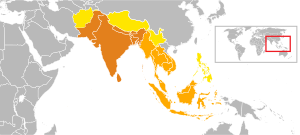
Back تاريخ النفوذ الهندي على جنوب شرق آسيا Arabic दक्षिणपूर्व एशिया पर भारतीय प्रभाव का इतिहास Hindi

Southeast Asia was in the Indian sphere of cultural influence from 290 BCE to the 15th century CE, when Hindu-Buddhist influences were incorporated into local political systems. Kingdoms in the southeast coast of the Indian subcontinent had established trade, cultural and political relations with Southeast Asian kingdoms in Burma, Bhutan, Thailand, the Sunda Islands, Malay Peninsula, Philippines, Cambodia, Laos, and Champa. This led to the Indianisation and Sanskritisation of Southeast Asia within the Indosphere, Southeast Asian polities were the Indianised Hindu-Buddhist Mandala (polities, city states and confederacies).[citation needed]
Indian culture itself arose from various distinct cultures and peoples, also including early Southeast Asian, specifically Austroasiatic influence onto early Indians.[2] A reason for the acceptance of Indian culture and religious traditions in Southeast Asia was because Indian culture already had similarities to indigenous cultures of Southeast Asia, which can be explained by earlier Southeast Asian (specifically Austroasiatic, such as early Munda and Mon Khmer groups), as well as later Himalayan (Tibetic) cultural and linguistic influence onto various Indian groups. Several scholars, such as Professor Przyluski, Jules Bloch, and Lévi, among others, concluded that there is a significant cultural, linguistic, and political Mon-Khmer (Austroasiatic) influence on early Indian culture and traditions. India is seen a melting pot of western, eastern and indigenous traditions. This distinctly Indian cultural system was later adopted and assimilated into the indigenous social construct and statehood of Southeast Asian regional polity, which rulers gained power and stability, transforming small chieftains into regional powers.[3]
Unlike the other kingdoms which existed on the Indian subcontinent, the Pallava empire which ruled the southeastern coast of the Indian peninsula did not impose cultural restrictions on people who wished to cross the sea.[citation needed] The Chola empire, which executed the South-East Asian campaign of Rajendra Chola I and the Chola invasion of Srivijaya, profoundly impacted Southeast Asia. This impact led to more exchanges with Southeast Asia on the sea routes. Whereas Buddhism thrived and became the main religion in many countries of Southeast Asia, it became a minority religion in India.
The peoples of maritime Southeast Asia — present-day Malaysia, Indonesia and the Philippines — are thought to have migrated southward from South China sometime between 2500 and 1500 BC. The influence of the civilization which existed on the Indian Subcontinent gradually became predominant among them, and it also became predominant among the peoples which lived on the Southeast Asian mainland.
Southern Indian traders, adventurers, teachers and priests continued to be the dominating influences in Southeast Asia until about 1500 CE. Hinduism and Buddhism both spread to these states from India and for many centuries, they existed there with mutual toleration. Eventually the states of the mainland mainly became Buddhist.
- ^ Kulke, Hermann (2004). A history of India. Rothermund, Dietmar, 1933– (4th ed.). New York: Routledge. ISBN 0-203-39126-8. OCLC 57054139.
- ^ Lévi, Sylvain; Przyluski, Jean; Bloch, Jules (1993). Pre-Aryan and Pre-Dravidian in India. Asian Educational Services. ISBN 978-81-206-0772-9.
- ^ Lévi, Sylvain; Przyluski, Jean; Bloch, Jules (1993). Pre-Aryan and Pre-Dravidian in India. Asian Educational Services. ISBN 978-81-206-0772-9.
It has been further proved that not only linguistic but also certain cultural and political facts of ancient India, can be explained by Austroasiatic (Mon-Khmer) elements.